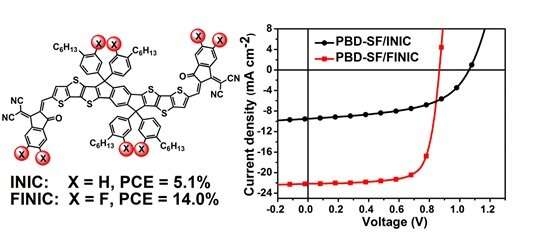Researchers develop fused-ring electron acceptor with 3-D exciton and charge transport

Recently, Professor Zhan Xiaowei's group from the College of Engineering at Peking University made progress in non-fullerene acceptors for organic solar cells (OSCs). They developed a new fluorinated fused-ring electron acceptor (FREA) with 3-D stacking and exciton and charge transport (Adv. Mater., DOI: 10.1002/adma.202000645).
In 2015, the Zhan group pioneered the concept of FREA and invented the landmark molecule ITIC. In 2017, they firstly introduced fluorinated 2-(3-oxo-2,3-dihydroinden-1-ylidene) -malononitrile, 1FIC and 2FIC, in FREAs (J. Am. Chem. Soc., 2017, 139, 1336–1343, cited 547 times; Adv. Mater., 2017, 29, 1700144, cited 549 times). Now, all the best non-fullerene acceptors are based on 1FIC/2FIC.
Most recently, they proposed a new design strategy to construct FREAs via fluorination of both end-groups and side-chains. Close 3-D stacking network is formed due to 3-D non-covalent interactions caused by F atoms on both end-groups and side-chains, which is beneficial to efficient 3-D exciton and charge transport. The OSCs based on FINIC with fluorinated end-groups and side-chains show an efficiency of 14.0%, much higher than that of the nonfluorinated INIC-based cells (5.1%).
More information: Shuixing Dai et al. High-Performance Fluorinated Fused-Ring Electron Acceptor with 3D Stacking and Exciton/Charge Transport, Advanced Materials (2020). DOI: 10.1002/adma.202000645
Journal information: Advanced Materials
Provided by Peking University





















